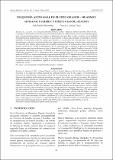Por favor, use este identificador para citar o enlazar este ítem:
https://hdl.handle.net/20.500.12958/4046| Título : | Pesquería artesanal de Puerto Grande – Huarmey |
| Otros títulos : | Artisanal fisheries in Puerto Grande, Huarmey |
| Autor : | Baldeón Hernández, Aldo Ganoza Chozo, Francisco |
| Palabras clave : | Pesquería artesanal;Puerto Grande;Huarmey |
| Fecha de publicación : | mar-2022 |
| Editorial : | Instituto del Mar del Perú |
| Citación : | Baldeón A., Ganoza F. 2022. Pesquería artesanal de Puerto Grande – Huarmey. Inf Inst Mar Perú. 49(1): 96-106. |
| Citación : | Informe IMARPE 49(1), 2022; |
| Resumen : | La pesquería artesanal en Huarmey tiene importancia debido al abastecimiento de recursos hidrobiológicos para consumo humano directo que, incluso es distribuido en Lima. Este estudio se realizó con la finalidad de diagnosticar la problemática y contribuir en la propuesta de bases para sustentar la actividad y el medio ambiente. Se obtuvieron datos de captura por especies y características de embarcaciones. En el área de desembarque se efectuó el seguimiento diario de la pesca artesanal, esfuerzo y zonas de pesca, así como toma de encuestas para obtener datos sociales del pescador, características de embarcación, motor, arte de pesca, equipos acústicos. En el 2003, se desembarcó 146,3 t, constituido por 62 especies de peces, invertebrados y algas marinas, entre los que destacaron: lorna Sciaena deliciosa (33.280 kg), cabrilla Paralabrax humeralis (14.768 kg), pejerrey Odontesthes regia regia (13.970 kg), jurel Trachurus murphyi (13.665 kg). El esfuerzo de pesca fue
3.505 viajes con pesca (VCP), la pinta representó el mayor esfuerzo con 1.870 VCP. La captura por unidad de esfuerzo (CPUE) con mayor rendimiento es para el espinel (0,950 t/VCP) seguido del cerco (0,158 t/VCP). La flota artesanal estuvo constituida por 119 embarcaciones distribuidos en pinteros 53% (63), embarcaciones sin motor 60% (71), la capacidad de bodega de la mayoría es menor a 1 t, que representa 45% (54) del total de las embarcaciones. La temperatura superficial del mar fluctuó entre 14,9 °C y 19,0 °C con anomalía térmica (ATSM) de - 0,3 °C. ABSTRACT: Huarmey is an important fishing ground for artisanal fisheries due to the supply of hydrobiological resources for direct human consumption, which are also distributed in Lima. Therefore, our study aimed to diagnose the problem and to propose guidelines to support the activity and the environment. We obtained data on catches by species and vessel characteristics. At the landing site, daily monitoring of artisanal fishing, effort, and fishing grounds was carried out, as well as surveys to obtain social data on the fishermen, vessel characteristics, motor, fishing gear, and acoustic equipment. A total of 146.3 tons were landed in 2003, made up of 62 species of fish, invertebrates, and seaweed, including lorna drum Sciaena deliciosa (33,280 kg), Peruvian rock seabass Paralabrax humeralis (14,768 kg), Peruvian silverside Odontesthes regia regia (13,970 kg), jack mackerel Trachurus murphyi (13,665 kg). The fishing effort was 3,505 fishing trips (FT), the handline represented the greatest effort with 1,870 FT. The catch per unit of effort (CPUE) with the highest yield was for the longline (0.950 t/FT) followed by the purse seine (0.158 t/FT). The artisanal fleet was formed by 119 boats, which were distributed as follows: handliners 53% (63), non-motorized boats 60% (71), most of which have a hold capacity of less than 1 t, representing 45% (54) of the total number of vessels. The sea surface temperature (SST) ranged between 14.9 °C and 19.0 °C with a thermal anomaly (SSTA) of -0.3 °C. |
| URI : | https://hdl.handle.net/20.500.12958/4046 |
| ISSN : | 0378-7702 |
| Aparece en las colecciones: | Informe vol. 49(1) 2022 |
Ficheros en este ítem:
| Fichero | Descripción | Tamaño | Formato | |
|---|---|---|---|---|
| Informe 49-1 artículo5.pdf | 2,65 MB | Adobe PDF |  Visualizar/Abrir |
Este ítem está sujeto a una licencia Creative Commons Licencia Creative Commons

